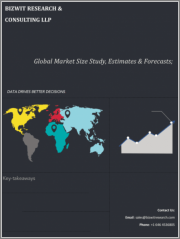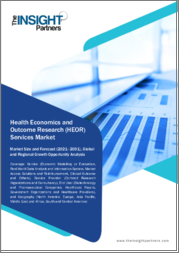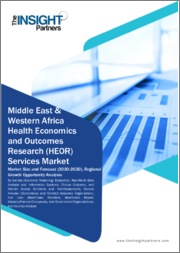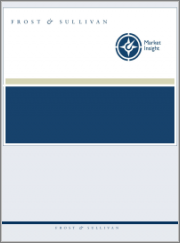
|
시장보고서
상품코드
1269614
세계의 질병 예측 분석 시장 규모 조사 및 예측 : 컴포넌트별, 전개별, 최종사용자별, 지역별 분석(2022-2029년)Global Predictive Disease Analytics Market Size study & Forecast, by Component by Deployment, by End User and Regional Analysis, 2022-2029 |
||||||
세계의 질병 예측 분석 시장은 2021년에 약 16억 3,000만 달러로 평가되고, 예측기간 2022-2029년에는 22.70% 이상의 건전한 성장률로 성장할 것으로 예측됩니다.
예측 분석은 데이터 마이닝, 통계, 모델링, 인공지능, 머신 러닝 등 최신 데이터를 분석하고 향후 예측을 수행하는 다양한 기술을 사용합니다. 헬스케어 분야에서는 예측 분석의 활용으로 여러 영역에서 개선이 이루어지고 있습니다. 여기에는 병원 관리, 공급망 단순화, 만성 질환 치료 등이 포함됩니다. 질병 예측 분석 시장은 맞춤형 의료의 상승과 헬스케어 산업에서의 디지털 기술 채택의 증가와 같은 요인으로 확대되고 있습니다.
예측 분석 도구는 정부 이니셔티브의 증가와 이 분야에 대한 재정 투자의 증가가 중복되어 헬스케어 분야에서 더 널리 사용되고 있습니다. 예를 들어 2023년 2월 유럽위원회는 신규암 치료제의 임상 데이터를 수집·평가하기 위한 AI 기반 플랫폼을 구축하고 규제 당국과 HTA 기관의 평가를 지원하는 것을 목적으로 한 새로운 프로젝트에 720만 달러를 할당했습니다. 이와 마찬가지로 미국 정부는 임상 데이터, 지역 건강 실적, 의학적 및 과학적 지식과 같은 주제에 대한 많은 연방 정부 데이터베이스에서 데이터를 결합한 HealthData.gov 포털 등이 분야에서 많은 노력을 시작하고 있습니다. 또한 기술의 급속한 발전과 엄청난 투자로 헬스케어 분야가 빠르게 디지털화되고 있습니다. 이러한 분석 도구는 환자의 체류를 관리하기 위해 전세계적으로 사용되고 있습니다. 또한 헬스케어 분석을 사용하면 직원의 생산성을 높이고 환자 관리를 강화하며 간병인의 스트레스를 줄일 수 있습니다. 연구 및 케어에 혁신을 가져오기 위해 데이터 브릭스는 2022년 3월 의료 및 생명과학 업계를 위한 패러다임 '레이크하우스'를 개발했습니다. 질병 예측, 의료 영상 분류, 바이오마커 식별을 위한 분석, 데이터 관리, 최첨단 AI를 모두 하나의 플랫폼에서 수행할 수 있습니다. 이와 같이 의료 분야에서의 제품 개발 활동과 정부로부터의 자금 제공의 증가가 시장의 성장을 뒷받침하고 있습니다. 그러나 질병 예측 분석의 비용이 높기 때문에 2022년부터 2029년까지의 예측기간 동안 시장 성장을 저해하고 있습니다.
질병 예측 분석 세계 시장 조사에서 고려된 주요 지역은 아시아태평양, 북미, 유럽, 중남미 및 기타 라틴아메리카입니다. 북미는 헬스케어 산업에서의 디지털 기술 도입의 증가, 맞춤형 의료의 연구개발의 증가, 산업에 대한 정부의 지원의 증가에 의해 수익면에서 시장을 독점하고 있습니다. 한편 아시아태평양은 정부 지원 및 이니셔티브 증가, 만성 질환 증가, 제품 개척을 위한 제휴 증가, 주요 진입 기업의 지역 확대, 정부 기관 및 비영리 단체 시장 진입 등의 요인으로부터 예측기간 동안 최고의 CAGR로 성장할 것으로 예상됩니다.
이 연구의 목적은 최근 몇 년 동안 다양한 부문과 국가의 시장 규모를 파악하고 앞으로 수년간의 시장 규모를 예측하는 것입니다. 이 보고서는 조사 대상 국가 산업의 질적 및 양적 측면을 포함하도록 설계되었습니다.
또한 시장의 미래 성장을 규정하는 촉진요인과 과제 등 중요한 측면에 대한 자세한 정보도 제공하고 있습니다. 또한 경쟁 상황과 주요 기업이 제공하는 컴포넌트에 대한 상세한 분석과 함께 이해관계자가 투자할 수 있는 미시적 시장에서의 잠재적인 기회도 포함하고 있습니다.
목차
제1장 주요 요약
- 시장 현황
- 세계·부문별 시장 추정·예측, 2019-2029년
- 질병 예측 분석 시장, 지역별, 2019-2029년
- 질병 예측 분석 시장, 컴포넌트별, 2019-2029년
- 질병 예측 분석 시장, 전개별, 2019-2029년
- 질병 예측 분석 시장, 최종사용자별, 2019-2029년
- 주요 동향
- 조사 방법
- 조사의 가정
제2장 질병 예측 분석 세계 시장 정의와 범위
- 조사 목적
- 시장 정의와 범위
- 조사 대상 범위
- 산업의 진화
- 본 조사의 대상이 된 해
- 환율 변환율
제3장 질병 예측 분석 세계 시장 역학
- 질병 예측 분석 시장의 영향 분석(2019-2029년)
- 시장 촉진요인
- 맞춤형 의료의 대두
- 헬스케어 업계에서의 디지털 기술 도입의 증가
- 시장의 과제
- 질병 예측 분석의 높은 비용
- 시장 기회
- 헬스케어 산업에 있어서의 정부 자금의 증가
- 기술의 급속한 진보
- 시장 촉진요인
제4장 세계의 질병 예측 분석 시장 산업 분석
- Porter's 5 Force 모델
- 공급기업의 협상력
- 구매자의 협상력
- 신규 참가업체의 위협
- 대체품의 위협
- 경쟁 기업 간의 적대 관계
- Porter's 5 Force 모델에 대한 미래적 접근(2019-2029년)
- PEST 분석
- 정치적
- 경제적
- 사회적
- 기술적
- 주요 투자 기회
- 주요 성공 전략
- 업계 관계자 전망
- 애널리스트의 권고와 결론
제5장 위험 평가: COVID-19의 영향
- COVID-19가 업계에 미치는 전체적인 영향에 대한 평가
- COVID-19 이전과 COVID-19 이후의 시장 시나리오
제6장 질병 예측 분석 세계 시장 : 컴포넌트별
- 시장 현황
- 질병 예측 분석 세계 시장 : 컴포넌트별, 실적 - 잠재력 분석
- 질병 예측 분석 세계 시장 컴포넌트별 추정·예측 2019-2029
- 질병 예측 분석 시장, 하위 부문 분석
- 소프트웨어 & 서비스
- 하드웨어
제7장 질병 예측 분석 세계 시장, 전개별
- 시장 현황
- 질병 예측 분석 세계 시장 : 전개별, 실적 - 잠재력 분석
- 질병 예측 분석 세계 시장 전개별 추정·예측 2019-2029
- 질병 예측 분석 시장, 하위 부문 분석
- 온프레미스
- 클라우드 기반
제8장 질병 예측 분석 세계 시장 : 최종사용자별
- 시장 현황
- 질병 예측 분석 세계 시장 : 최종사용자별, 실적 - 잠재력 분석
- 질병 예측 분석 세계 시장 최종사용자별 추정·예측 2019-2029
- 질병 예측 분석 시장, 하위 부문 분석
- 헬스케어 페이어
- 헬스케어 프로바이더
- 기타 최종사용자
제9장 질병 예측 분석 세계 시장 : 지역별 분석
- 질병 예측 분석 시장, 지역별 시장 현황
- 북미
- 미국
- 컴포넌트별 추정·예측, 2019-2029년
- 전개별 추정·예측, 2019-2029년
- 최종사용자별 추정·예측, 2019-2029년
- 캐나다
- 미국
- 유럽의 질병 예측 분석 시장 현황
- 영국
- 독일
- 프랑스
- 스페인
- 이탈리아
- 기타 유럽
- 아시아태평양의 질병 예측 분석 시장 현황
- 중국
- 인도
- 일본
- 호주
- 한국
- 기타 아시아태평양
- 라틴아메리카의 질병 예측 분석 시장 현황
- 브라질
- 멕시코
- 기타 라틴아메리카
- 세계의 기타 지역
제10장 경쟁 정보
- 주요 시장 전략
- 기업 개요
- Oracle Corporation
- 주요 정보
- 개요
- 재무(데이터의 입수가 가능한 경우만)
- 제품 개요
- 최근 동향
- International Business Machines(IBM) Corporation
- SAS Software
- Allscripts Healthcare Solutions Inc.
- MedeAnalytics, Inc.
- Health Catalyst.
- Apixio Inc.
- Microsoft Corporation
- UnitedHealth Group Incorporated(Optum Inc.),
- Cerner Corporation
- Oracle Corporation
제11장 조사 프로세스
- 조사 프로세스
- 데이터 마이닝
- 분석
- 시장 추정
- 검증
- 출판
- 조사의 특징
- 조사의 가정
Global Predictive Disease Analytics Market is valued approximately USD 1.63 billion in 2021 and is anticipated to grow with a healthy growth rate of more than 22.70% over the forecast period 2022-2029. Predictive analytics uses a variety of techniques to analyze the most recent data and make future predictions, including data mining, statistics, modelling, artificial intelligence, and machine learning. The healthcare sector has made improvements in several areas by using predictive analytics. These include administering a hospital, simplifying the supply chain, and treating chronic diseases. The Predictive Disease Analytics market is expanding because of factors such as rising emergence of personalized medicine, rising adoption of digital technologies in healthcare industry.
Predictive analytical tools are being more widely used in the healthcare sector due to a combination of rising government initiatives and rising financial investments in the area. For instance, in February 2023, the European Commission allocated USD 7.2 million for a new project that aims to create an AI-based platform for gathering and evaluating clinical data on novel oncology drugs to help regulators' and HTA agencies' evaluations of those drugs. Similar to this, the American government has launched a number of initiatives in this area, such as the HealthData.gov portal, which compiles data from a number of federal databases on subjects like clinical data, community health performance, and medical and scientific knowledge. In addition, the healthcare sector is rapidly becoming digitalized due to the quick development of technology and significant investment made by the sector. These analytical tools are being used all around the world to control patients' retention. The use of healthcare analytics also boosts employee productivity, enhances patient care, and lessens the stress on carers. To bring innovation in research and care, Databricks developed the Lakehouse paradigm for the healthcare and life science industries in March 2022. Analytics, data management, and cutting-edge AI for disease prediction, medical picture classification, and biomarker identification can all be done on one platform. Thus rising product development activities and government funding in healthcare sector is catering the market growth. However, the high cost of Predictive Disease Analytics stifles market growth throughout the forecast period of 2022-2029.
The key regions considered for the Global Predictive Disease Analytics Market study includes Asia Pacific, North America, Europe, Latin America, and Rest of the World. North America dominated the market in terms of revenue, owing to rising adoption of digital technologies in healthcare industry, rising research and development of personalized medicine and rising government support to the industry. Whereas Asia Pacific is expected to grow with a highest CAGR during the forecast period, owing to factors such as increasing government support and initiative, growing chronic disease in the region an increase in the number of collaborations for product development, geographic expansion of key players, and active participation of government and nonprofit organizations in the market space.
Major market player included in this report are:
- Oracle Corporation
- International Business Machines (IBM) Corporation
- SAS Software
- Allscripts Healthcare Solutions Inc.
- MedeAnalytics, Inc.
- Health Catalyst.
- Apixio Inc.
- Microsoft Corporation
- UnitedHealth Group Incorporated (Optum Inc.),
- Cerner Corporation
Recent Developments in the Market:
- In September 2020, Microsoft, a U.S.-based company, unveiled Microsoft Cloud for Healthcare, a partnership between patients and providers that will aid in providing improved patient care insights.
- In January 2023, SwitchPoint Ventures and Ardent Health Service partnered to launch an innovation lab. The studio will focus on developing and putting into practise data-driven solutions. Ardent has also implemented Polaris, a game-changing technology from SwitchPoint that accurately forecasts patient volume in any clinical setting.
Global Predictive Disease Analytics Market Report Scope:
- Historical Data 2019-2020-2021
- Base Year for Estimation 2021
- Forecast period 2022-2029
- Report Coverage Revenue forecast, Company Ranking, Competitive Landscape, Growth factors, and Trends
- Segments Covered Component, Deployment, End User, Region
- Regional Scope North America; Europe; Asia Pacific; Latin America; Rest of the World
- Customization Scope Free report customization (equivalent up to 8 analyst's working hours) with purchase. Addition or alteration to country, regional & segment scope*
The objective of the study is to define market sizes of different segments & countries in recent years and to forecast the values to the coming years. The report is designed to incorporate both qualitative and quantitative aspects of the industry within countries involved in the study.
The report also caters detailed information about the crucial aspects such as driving factors & challenges which will define the future growth of the market. Additionally, it also incorporates potential opportunities in micro markets for stakeholders to invest along with the detailed analysis of competitive landscape and component offerings of key players. The detailed segments and sub-segment of the market are explained below.
By Component:
- Software & Services
- Hardware
By Deployment:
- On-premises
- Cloud based
By End User:
- Healthcare Payers
- Healthcare Providers
- Other End Users
By Region:
- North America
- U.S.
- Canada
- Europe
- UK
- Germany
- France
- Spain
- Italy
- ROE
- Asia Pacific
- China
- India
- Japan
- Australia
- South Korea
- RoAPAC
- Latin America
- Brazil
- Mexico
- RoLA
- Rest of the World
Table of Contents
Chapter 1. Executive Summary
- 1.1. Market Snapshot
- 1.2. Global & Segmental Market Estimates & Forecasts, 2019-2029 (USD Billion)
- 1.2.1. Predictive Disease Analytics Market, by Region, 2019-2029 (USD Billion)
- 1.2.2. Predictive Disease Analytics Market, by Component, 2019-2029 (USD Billion)
- 1.2.3. Predictive Disease Analytics Market, by Deployment, 2019-2029 (USD Billion)
- 1.2.4. Predictive Disease Analytics Market, by End User, 2019-2029 (USD Billion)
- 1.3. Key Trends
- 1.4. Estimation Methodology
- 1.5. Research Assumption
Chapter 2. Global Predictive Disease Analytics Market Definition and Scope
- 2.1. Objective of the Study
- 2.2. Market Definition & Scope
- 2.2.1. Scope of the Study
- 2.2.2. Industry Evolution
- 2.3. Years Considered for the Study
- 2.4. Currency Conversion Rates
Chapter 3. Global Predictive Disease Analytics Market Dynamics
- 3.1. Predictive Disease Analytics Market Impact Analysis (2019-2029)
- 3.1.1. Market Drivers
- 3.1.1.1. Rising emergence of personalized medicine
- 3.1.1.2. Rising adoption of digital technologies in healthcare industry
- 3.1.2. Market Challenges
- 3.1.2.1. High Cost of Predictive Disease Analytics
- 3.1.3. Market Opportunities
- 3.1.3.1. Increase in government funding in healthcare industry.
- 3.1.3.2. The rapid advancement in technology
- 3.1.1. Market Drivers
Chapter 4. Global Predictive Disease Analytics Market Industry Analysis
- 4.1. Porter's 5 Force Model
- 4.1.1. Bargaining Power of Suppliers
- 4.1.2. Bargaining Power of Buyers
- 4.1.3. Threat of New Entrants
- 4.1.4. Threat of Substitutes
- 4.1.5. Competitive Rivalry
- 4.2. Futuristic Approach to Porter's 5 Force Model (2019-2029)
- 4.3. PEST Analysis
- 4.3.1. Political
- 4.3.2. Economical
- 4.3.3. Social
- 4.3.4. Technological
- 4.4. Top investment opportunity
- 4.5. Top winning strategies
- 4.6. Industry Experts Prospective
- 4.7. Analyst Recommendation & Conclusion
Chapter 5. Risk Assessment: COVID-19 Impact
- 5.1. Assessment of the overall impact of COVID-19 on the industry
- 5.2. Pre COVID-19 and post COVID-19 Market scenario
Chapter 6. Global Predictive Disease Analytics Market, by Component
- 6.1. Market Snapshot
- 6.2. Global Predictive Disease Analytics Market by Component, Performance - Potential Analysis
- 6.3. Global Predictive Disease Analytics Market Estimates & Forecasts by Component 2019-2029 (USD Billion)
- 6.4. Predictive Disease Analytics Market, Sub Segment Analysis
- 6.4.1. Software & Services
- 6.4.2. Hardware
Chapter 7. Global Predictive Disease Analytics Market, by Deployment
- 7.1. Market Snapshot
- 7.2. Global Predictive Disease Analytics Market by Deployment, Performance - Potential Analysis
- 7.3. Global Predictive Disease Analytics Market Estimates & Forecasts by Deployment 2019-2029 (USD Billion)
- 7.4. Predictive Disease Analytics Market, Sub Segment Analysis
- 7.4.1. On-premises
- 7.4.2. Cloud based
Chapter 8. Global Predictive Disease Analytics Market, by End User
- 8.1. Market Snapshot
- 8.2. Global Predictive Disease Analytics Market by End User, Performance - Potential Analysis
- 8.3. Global Predictive Disease Analytics Market Estimates & Forecasts by End User 2019-2029 (USD Billion)
- 8.4. Predictive Disease Analytics Market, Sub Segment Analysis
- 8.4.1. Healthcare Payers
- 8.4.2. Healthcare Providers
- 8.4.3. Other End Users
Chapter 9. Global Predictive Disease Analytics Market, Regional Analysis
- 9.1. Predictive Disease Analytics Market, Regional Market Snapshot
- 9.2. North America Predictive Disease Analytics Market
- 9.2.1. U.S. Predictive Disease Analytics Market
- 9.2.1.1. Component breakdown estimates & forecasts, 2019-2029
- 9.2.1.2. Deployment breakdown estimates & forecasts, 2019-2029
- 9.2.1.3. End User breakdown estimates & forecasts, 2019-2029
- 9.2.2. Canada Predictive Disease Analytics Market
- 9.2.1. U.S. Predictive Disease Analytics Market
- 9.3. Europe Predictive Disease Analytics Market Snapshot
- 9.3.1. U.K. Predictive Disease Analytics Market
- 9.3.2. Germany Predictive Disease Analytics Market
- 9.3.3. France Predictive Disease Analytics Market
- 9.3.4. Spain Predictive Disease Analytics Market
- 9.3.5. Italy Predictive Disease Analytics Market
- 9.3.6. Rest of Europe Predictive Disease Analytics Market
- 9.4. Asia-Pacific Predictive Disease Analytics Market Snapshot
- 9.4.1. China Predictive Disease Analytics Market
- 9.4.2. India Predictive Disease Analytics Market
- 9.4.3. Japan Predictive Disease Analytics Market
- 9.4.4. Australia Predictive Disease Analytics Market
- 9.4.5. South Korea Predictive Disease Analytics Market
- 9.4.6. Rest of Asia Pacific Predictive Disease Analytics Market
- 9.5. Latin America Predictive Disease Analytics Market Snapshot
- 9.5.1. Brazil Predictive Disease Analytics Market
- 9.5.2. Mexico Predictive Disease Analytics Market
- 9.5.3. Rest of Latin America Predictive Disease Analytics Market
- 9.6. Rest of The World Predictive Disease Analytics Market
Chapter 10. Competitive Intelligence
- 10.1. Top Market Strategies
- 10.2. Company Profiles
- 10.2.1. Oracle Corporation
- 10.2.1.1. Key Information
- 10.2.1.2. Overview
- 10.2.1.3. Financial (Subject to Data Availability)
- 10.2.1.4. Product Summary
- 10.2.1.5. Recent Developments
- 10.2.2. International Business Machines (IBM) Corporation
- 10.2.3. SAS Software
- 10.2.4. Allscripts Healthcare Solutions Inc.
- 10.2.5. MedeAnalytics, Inc.
- 10.2.6. Health Catalyst.
- 10.2.7. Apixio Inc.
- 10.2.8. Microsoft Corporation
- 10.2.9. UnitedHealth Group Incorporated (Optum Inc.),
- 10.2.10. Cerner Corporation
- 10.2.1. Oracle Corporation
Chapter 11. Research Process
- 11.1. Research Process
- 11.1.1. Data Mining
- 11.1.2. Analysis
- 11.1.3. Market Estimation
- 11.1.4. Validation
- 11.1.5. Publishing
- 11.2. Research Attributes
- 11.3. Research Assumption



















